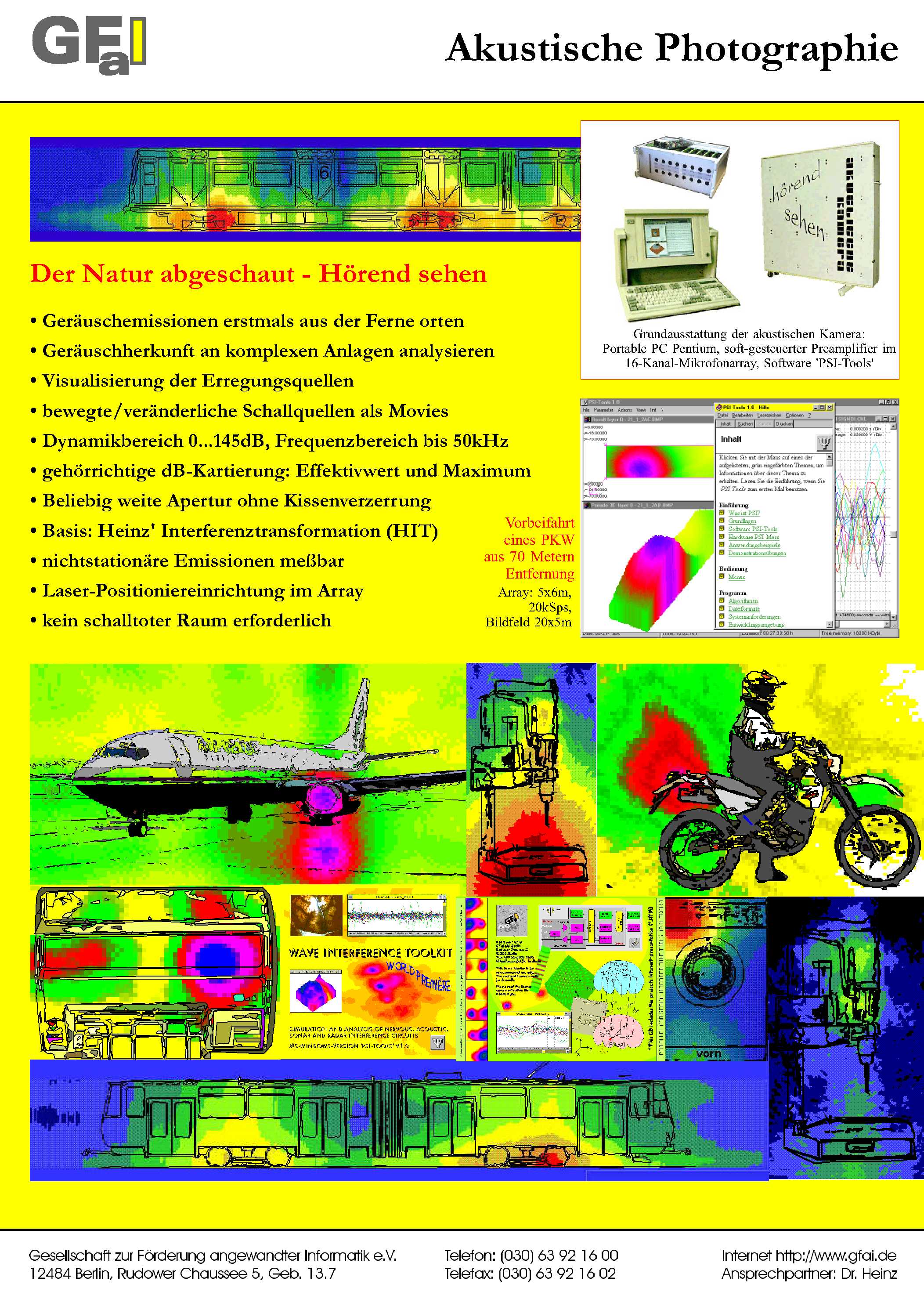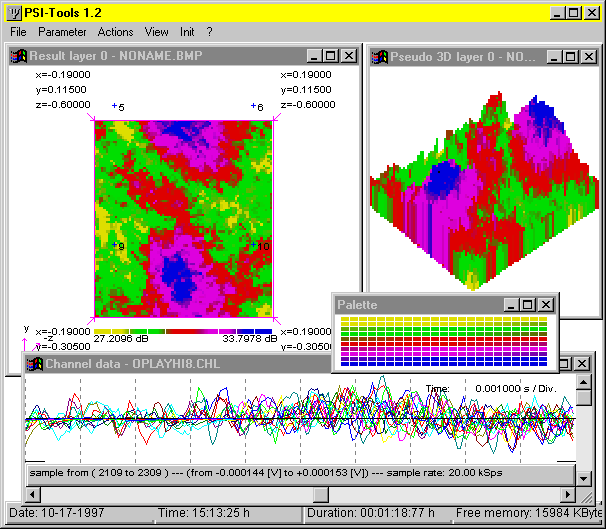Bilder leuchten laut
Funktionen
Hardware
Mikrophon-Arrays
Software PSI-Tools
Interferenzschaltungen
Short History PDF 16 MB
Worldwide First Acoustic Images
(1994-1997)
Origin of the Name "Acoustic Camera"
Remark 2023: At the "Hannover Industrie" fair in April 1997 we presented a "16-channel acoustic interference measurement station". A reporter from the Berliner Zeitung, Dr. Michael Ochel, visited the stand. "I'm interested in new technologies. Can you please tell me, what this is?" I told him, that the device can produce acoustic images and films. And he answered: "If it is so clear, why didn`t you call it Acoustic Camera?" So we did. Find his story in the press-directory 1997. More about historical records of the Acousic Camera see here.
An authentic document of this time ist the application for the "Philip Morris Forschungspreis" dated to October 1997 (PDF). Find first images and movies here. The following flyer gives some impressions. It was probably produced for the fair "Funkausstellung" in September 1997 (around the Funkturm Berlin).

Flyer for the "Funkausstellung" Sept. 1997 BerlinThe Acoustic Camera consists of a PC-based 16-channel data recorder and the software PSI-Tools (Parallel and Serial Interference Tools) to reconstruct acoustic images from microphone records. PSI-Tools is a selective tool for acoustic excitment mapping. The core algorithm I called "H-Interference Transformation (HIT)". It was more flexible and simpler, compared with known beamforming algorithms at that time (compare with Johnson/Dudgeon: Array Signal Processing, Prentice-Hall 1993, p.112 ff).
By the way: First we got the first acoustic images. A long time later we were told, that lots of acoustic institutes wordwide work at acoustic images under the names "acoustic antenna" and "beamforming".
It was the first system, that could produce passive, acoustic images and films of standing, noise-emitting objects. This images and films were going around the world.
One of the early congratulations came from Prof. Dr. Michel, DLR. (email 1997). He was a pioneer in acoustic noise measurements of airplanes.
Software PSI-Tools
PSI-Tools reconstructs the time-function for each pixle of an acoustic image. Then PSI-Tools takes the effective value of these time function to set the color of a pixle.
PSI-Tools runs under Microsofts Windows95. For details see software and function of the tool. Find a description of PSI-Tools here.
PSI-Help File System

It includes a powerfull help-file system. Download the help-file and PSI-Tools here.
PSI-Tools Surface

The channel data comes from 16 microphones. They cary very different signals. The differences allow to transform the channel data into the excitment location map using the authors Interference Transformation (HIT).
Hardware of first Acoustic Camera
The portable PC-Pentium with analog-digital converter, preamplifier and microphone array allows to sample 16 channels in parallel with sampling rates until 50 or 100 kSps.
a) b)
c)

a) Portable PC
For outdoor measurement we needed a compact PC. The 200 MHz PC Intel-Pentium UMC of the company JET included two full size AT-bus-slots for a maximum of two 12-bit analog-digital-converter (ADC) cards UEIDAC WIN30-DS, see hardware. We used only one slot. The UMC was running under Windows95.b) 16-Channel Microphone Array
For measurements we used calibrated 1/2" measurement electret-microphones MK250 from Mikrotech Gefell with a frequency range from 100 Hz to 20 kHz. The 16 measuring microphones were arranged within an (not aliasing optimal) orthogonal array with a grid size of 30 cm. To avoid reflections, the microphone membranes have been placed planar to the front wall of the device. Included in the array is the 16-channel, programmable preamplifier (d), see arrays and a central laser-pointer for the overlay between acoustic image and photo. The laser points in negative Z direction, if the thumb of the right hand shows the X-axis and the index-finger shows the Y-axis.c) 16-Channel Soft-Controlled Preamplifier:
The 16-channel preamplifier was integrated in the housing of the array. For a detailed description see hardware.
Sources
- Heinz, G.: Verfahren und Prototyp zur Rekonstruktion eines dreidimensionalen, neuronalen Interferenzraumes. Kurztitel: Neuronale 3D-Rekonstruktion (NEURO3D)". Projektförderung durch BMWi, Nr. 415/1994, 1.1.1994 - 30.6.1995, GFaI Berlin, Sachbericht vom 20.12.1995, 41 S.
- Heinz, G.: Verfahren und Prototyp zur Erzeugung von Präzisionsbildern akustischer Laufzeitfelder durch Nutzung paralleler und serieller Interferenz (PSI). Projektförderung durch BMWi, Nr. 744/95, 1.6.1995 - 31.5.1996, GFaI Berlin, Sachbericht vom 1.12.1996, 16 S.
Mail send? info@gheinz.de
File created Oct. 17, 1997; 14:38
Adds and remarks: 02/2023, 06/2023Access nr.

